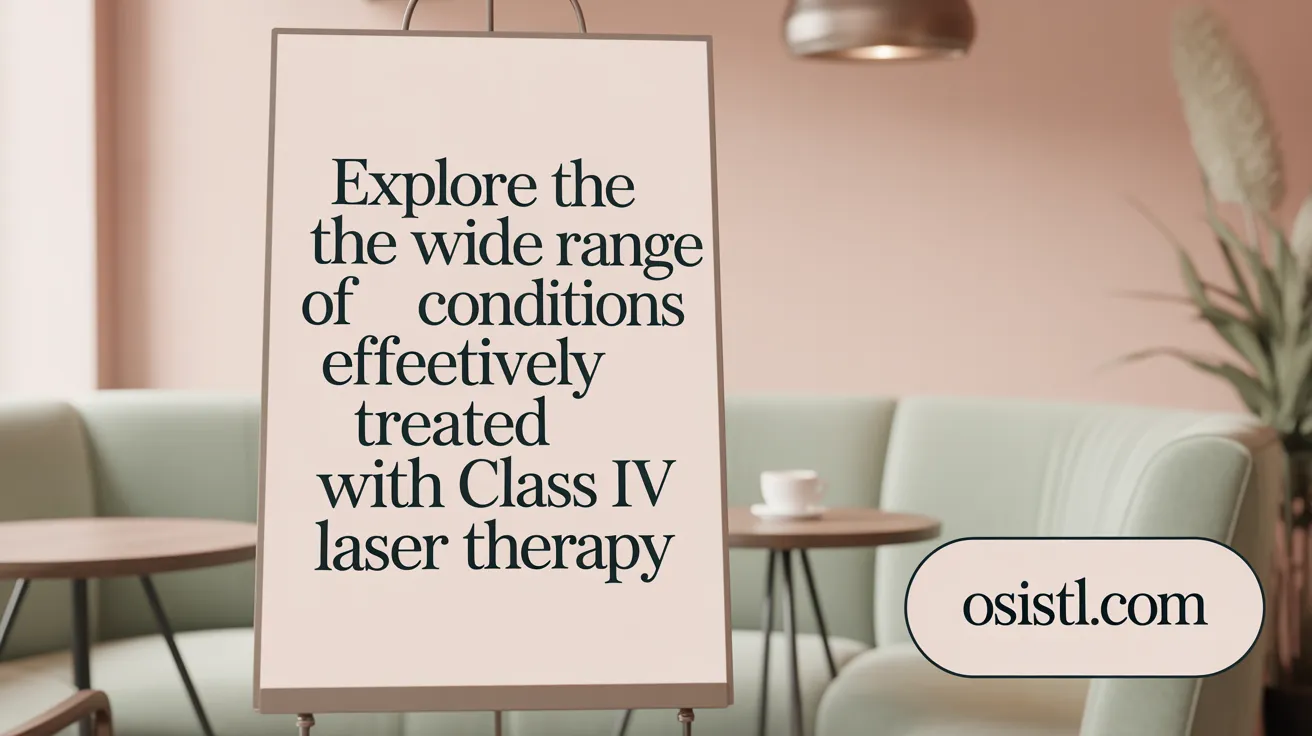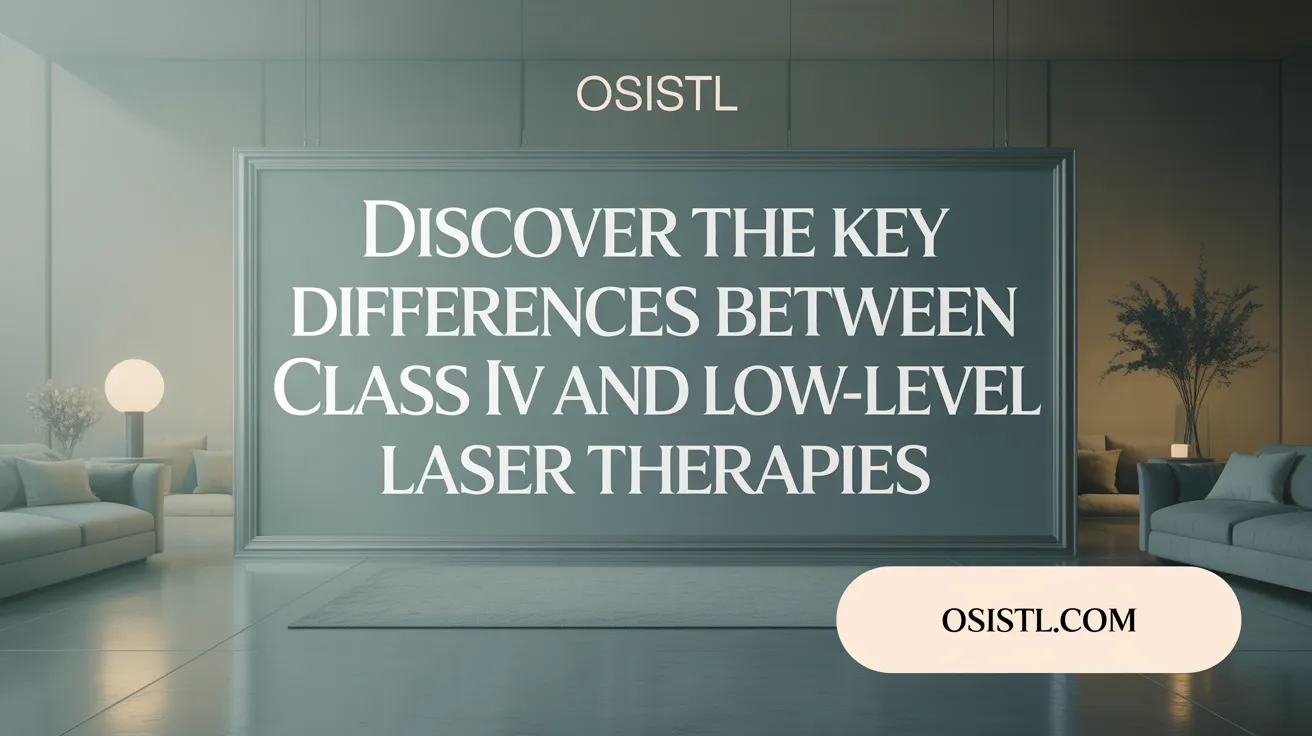Understanding the Promise of Class IV Laser Therapy
Back pain remains one of the most prevalent health challenges worldwide, motivating a continuous search for effective, non-invasive treatments. Class IV laser therapy, a cutting-edge approach utilizing high-powered lasers, is transforming how clinicians manage back pain by offering accelerated healing, targeted pain relief, and enhanced mobility. This article explores the science behind Class IV laser therapy, its benefits for back pain, how it compares to other treatment modalities, and its growing role in comprehensive care.
What is Class IV Laser Therapy and How Does It Work?
What is Class IV Laser Therapy?
Class IV laser therapy is a non-invasive treatment that employs high-powered lasers emitting light at levels above 500 milliwatts, allowing deeper penetration into muscles, ligaments, bones, and other tissues. It is used to stimulate healing and reduce pain in musculoskeletal conditions, especially where deeper tissue damage is involved.
How Does Class IV Laser Therapy Work at the Cellular Level?
The therapy functions through photobiomodulation mechanism in Class IV laser therapy, where laser light stimulates mitochondria in cells to produce increased levels of adenosine triphosphate (ATP). ATP is the energy currency of the cell and its increase supports faster tissue repair, reduces inflammation, and improves blood flow. This cascade of cellular events leads to reduced nerve sensitivity and enhanced healing.
Differences from Lower-Class Lasers
Unlike low-level or Class III cold lasers, Class IV lasers produce heat due to their higher power output lasers, amplifying their ability to penetrate much deeper tissue layers—sometimes up to 10 centimeters. These laser beams can simultaneously target multiple injured sites in short sessions, enhancing therapeutic effects for chronic and deep-seated pain, such as Laser therapy for back pain.
What Happens During a Treatment Session?
Typical Class IV laser therapy sessions last between 5 to 20 minutes, depending on the condition and area treated. Patients often experience a soothing warmth with no pain during treatment. Sessions are usually recommended 2 to 3 times a week initially, with adjustments based on individual response (Class IV deep tissue laser therapy).
Wavelengths and Photobiomodulation Effects
Class IV lasers use specific wavelengths typically ranging from 650 to 1064 nanometers, combining visible red and near-infrared light. Different wavelengths evoke targeted effects such as superficial tissue treatment (around 650 nm), increased cellular ATP production (810 nm), enhanced circulation (915 nm), and pain relief (980 nm). This selective photobiomodulation optimizes healing and reduces swelling in damaged back tissues.
Clinical Applications: Conditions Treated by Class IV Laser Therapy

What conditions can Class IV laser therapy treat?
Class IV laser therapy is a versatile, non-invasive treatment option widely used for a range of musculoskeletal conditions. It effectively addresses chronic and acute pain affecting the back, neck, and limbs. Conditions like sciatica, arthritis (both degenerative and rheumatoid), tendonitis, bursitis, and various sports injuries respond well to this therapy. Beyond pain relief, it promotes accelerated tissue healing, reduces inflammation, enhances blood circulation, and facilitates faster recovery post-surgery. The therapy also supports wound healing and improves joint function and mobility, making it beneficial for both acute injuries and longstanding musculoskeletal disorders.
Is Class IV laser therapy effective for neuropathic pain and neuropathy?
Indeed, a significant strength of Class IV laser therapy lies in its application to nerve-related issues. It has been shown to improve nerve function and alleviate neuropathic symptoms such as pain, numbness, burning, and tingling sensations. This makes it a promising option for patients suffering from neuropathic pain and peripheral neuropathy, enhancing their quality of life by reducing discomfort and improving nerve regeneration.
How is Class IV laser therapy used for back pain and related disorders?
Chronic and acute back pain, including conditions such as disc herniation, spinal stenosis, and muscular strain, are commonly treated with Class IV laser therapy. By penetrating deep into muscle and bone tissues, it stimulates cellular processes that reduce inflammation and regenerate damaged tissues. This results in decreased pain, improved spinal mobility, and accelerated healing without the need for invasive procedures.
What about sports injuries and arthritis?
In sports medicine, Class IV laser therapy accelerates healing of soft tissue injuries such as sprains, strains, ligament tears, and tendonitis. It reduces inflammation and pain, enabling quicker return to activity. For arthritis patients, the therapy diminishes joint pain and stiffness while promoting cartilage repair and enhanced joint mobility, improving overall function.
Class IV laser therapy's ability to penetrate deeply and target diverse pathological processes highlights its broad clinical applicability, making it a valuable addition to modern pain management and rehabilitation strategies.
Evidence and Research Supporting Class IV Laser Therapy

Is Class IV laser therapy supported by scientific research?
Class IV laser therapy is backed by extensive scientific research, including over 6,000 clinical studies and randomized controlled trials. These studies demonstrate its effectiveness in reducing pain and improving function in various musculoskeletal disorders such as chronic low back pain, arthritis, and neuropathic conditions. Systematic reviews highlight significant pain reduction and enhanced disability outcomes for patients receiving Class IV laser therapy.
What do clinical studies reveal about pain reduction and functional improvement?
Research consistently shows notable decreases in pain levels immediately after treatment and during follow-up periods. Functional abilities including range of motion, muscle strength, and daily activity capacity improve alongside pain relief. The therapy stimulates ATP production in cells, accelerating tissue repair and promoting nerve regeneration, which contributes to lasting benefits. Clinical trials such as those conducted on High-power laser therapy for radicular low back pain provide supporting evidence.
How does Class IV laser therapy compare with low-level laser therapy?
Unlike low-level (cold) lasers operating below 500 milliwatts, Class IV lasers deliver higher power (>500 mW) with deeper tissue penetration (up to 10 cm). This enables treatment of deep-seated conditions more effectively and in shorter sessions. While low-level laser therapy is suitable for superficial tissues and nerve healing, Class IV lasers target muscles, ligaments, tendons, and bones, broadening therapeutic applications. For a detailed comparison, see Class IV vs Cold Laser Therapy.
What does research say about blood flow and tissue oxygenation?
Clinical studies have demonstrated that Class IV laser therapy increases limb blood flow and microcirculation. For example, a 3-W dose applied to forearm muscles significantly enhanced blood flow during and shortly after treatment. This vasodilation effect is believed to be mediated by nitric oxide signaling pathways, promoting nutrient delivery and waste removal to accelerate healing. See detailed findings on Laser Therapy and Blood Flow.
What safety and regulatory approvals are in place for Class IV lasers?
Class IV laser therapy has been FDA cleared for medical use since 2002-2003 for multiple indications including pain relief and muscle relaxation. It is considered safe under professional administration, with minimal side effects such as temporary warmth or redness. Precautions involve avoiding treatment over cancerous tissue, during pregnancy (abdomen), or on photosensitive individuals. Proper training and protective measures ensure safe delivery of therapy. More information is available at Class 4 Laser Therapy Benefits and Safety.
In summary, scientific evidence robustly supports Class IV laser therapy as an effective, safe, and non-invasive treatment for various chronic and acute musculoskeletal conditions. Its superior tissue penetration and demonstrated physiological benefits distinguish it from lower-level lasers, offering promising therapeutic outcomes for patients. For an overview of the benefits and clinical evidence, visit Laser Therapy for Pain - Unlocking the Power of Class 4 Laser Therapy.
Comparing Class IV Laser Therapy to Other Laser Treatments

How does Class IV laser therapy differ from low-level laser therapy (LLLT)?
Class IV laser therapy operates at power levels above 500 milliwatts, enabling it to penetrate deeply—up to 10 centimeters—into tissues. This high power produces a warming effect, allowing effective treatment of deep-seated conditions such as arthritis, spinal injuries, and certain sports-related damages.
In contrast, low-level laser therapy (LLLT), often called cold laser therapy, functions at powers below 500 milliwatts. It does not produce heat and primarily works on superficial tissues like nerves, tendons, and small joints, making it suitable for conditions involving surface tissue regeneration and nerve healing.
Differences in power, penetration, and heat production
The main distinctions between these modalities are:
- Power Output: Class IV lasers exceed 500 mW; LLLT lasers are under 500 mW.
- Tissue Penetration: Class IV lasers reach deeper tissues (up to 10 cm), while LLLT is limited to superficial layers.
- Heat Generation: Class IV lasers produce heat beneficial for modulating deep inflammation; LLLT is non-thermal, safe for heat-sensitive regions.
Surface vs. deep tissue treatment
Class IV laser therapy is ideal for addressing deep musculoskeletal and neuropathic conditions, including chronic back pain, deep arthritis, and post-surgical recovery. Low-level laser therapy tends to be preferred for more surface-level issues such as wound care, superficial nerve pain, and small joint inflammations.
Combined uses and patient suitability
Practitioners sometimes integrate both treatments, tailoring protocols to address complicated or multilayered injuries effectively. The choice depends on tissue depth affected, the chronicity and severity of pain, and individual patient tolerance to heat sensations. Class IV therapy sessions typically last 5–20 minutes, providing quicker results for deep conditions, whereas LLLT may require more sessions due to its milder energy delivery.
Benefits of Class IV Laser Therapy for Back Pain Management
What are the benefits of Class IV laser therapy for back pain?
Class IV laser therapy offers several advantages in managing back pain through a non-invasive and drug-free approach. It significantly reduces pain by decreasing nerve sensitivity and releasing natural endorphins, which alleviate discomfort without medication.
Additionally, this therapy reduces inflammation and swelling in the affected tissues. The use of specific therapeutic wavelengths increases blood circulation, enhancing nutrient and oxygen delivery that supports healing. Improved circulation also helps lessen muscle spasms and soreness associated with back pain.
The therapy accelerates tissue healing and regeneration by stimulating cellular activity and ATP production within cells. This leads to faster repair of muscles, ligaments, and tendons damaged by injury or chronic strain.
Patients often experience improved range of motion and mobility after treatment. By reducing stiffness and promoting tissue flexibility, Class IV laser therapy facilitates easier movement and supports rehabilitation efforts.
Notably, Class IV laser therapy provides an alternative to surgery and opioid use. It avoids invasive procedures and the side effects of long-term medication, offering quicker relief with minimal sessions typically lasting 5 to 20 minutes.
Overall, Class IV laser therapy is a safe, effective, and efficient solution for back pain management that enhances quality of life with minimal risks and downtime.
How Class IV Laser Therapy Integrates into Comprehensive Back Pain Care
How is Class IV laser therapy used in conjunction with other back pain treatments?
Class IV laser therapy is frequently integrated with other back pain treatments such as physical therapy for back pain, chiropractic care for back pain, and targeted exercise programs. This combination enhances pain relief and promotes functional recovery by stimulating deep tissue laser treatment while also strengthening muscles and improving mobility.
Combination with physical therapy and exercise
Pairing Class IV laser therapy with physical therapy allows patients to benefit from accelerated tissue repair alongside exercises that improve flexibility, core strength, and posture. This integrative approach helps address both symptoms and underlying causes of back pain, supporting long-term recovery and prevention of recurrence.
Patient assessment and tailored treatment plans
Healthcare providers conduct thorough evaluations—including patient history, physical examinations, and imaging when necessary—to develop individualized treatment strategies. Treatment frequency and duration with laser therapy are customized based on the patient’s condition severity and response to therapy, ensuring optimized outcomes.
Safety and consultation considerations
Class IV laser therapy is generally safe when performed by trained professionals. Patients are advised to discuss medical history, medications, and potential contraindications such as pregnancy, cancerous lesions, or open wounds. Open communication ensures treatment appropriateness and minimizes risks. Learn more about laser therapy safety and side effects.
Role alongside conservative and surgical approaches
This therapy serves as a valuable non-invasive pain management alternative or adjunct to traditional pain management methods, including pharmacologic treatments and surgery. It aligns with conservative care principles by reducing inflammation and pain without medication side effects, and may even decrease the need for invasive procedures. For surgical candidates, laser therapy can support postoperative healing and reduce recovery time.
By integrating Class IV laser therapy into a multimodal back pain management plan, clinicians can offer patients a comprehensive, patient-centered approach that addresses pain, function, and overall well-being effectively.
Patient Experience and Practical Considerations

What can patients expect during and after Class IV laser therapy sessions?
Treatment sessions typically last between 5 to 10 minutes, making it a quick and convenient option for pain relief and healing. Most patients undergo multiple sessions, commonly two to three times per week at the start, with the exact number tailored to individual needs and the specific condition being treated.
During therapy, patients often experience a soothing warmth during laser therapy or a mild tingling sensation over the treated area, but the process is generally painless. Some individuals notice relief after just one or two treatments, although the full benefits—such as reduced pain, decreased inflammation, and improved mobility—tend to build progressively over the course of several sessions. Importantly, there is typically no downtime required, allowing patients to resume normal activities immediately after treatment.
Are there any limitations or precautions for using Class IV laser therapy?
While Class IV laser therapy is safe for most patients, certain precautions must be considered. It is not recommended for individuals who are pregnant or those with cancerous lesions in the treatment area. People with photosensitivity, pacemakers, or active infections or open wounds should consult their healthcare provider before starting therapy, as these conditions may contraindicate treatment.
Accessibility is another practical consideration. Many insurance plans do not cover Class IV laser therapy, which may limit patient access due to out-of-pocket costs. Treatments are primarily available in outpatient clinics, specialized centers, chiropractic offices, and physical therapy clinics, which can vary depending on location. Patients are encouraged to discuss availability, costs, and any specific health concerns with their healthcare provider to determine if Class IV laser therapy is a suitable and feasible option for their pain management or recovery plan.
Future Perspectives and Ongoing Research

What does the future hold for Class IV laser therapy in back pain?
The future of Class IV laser therapy in managing back pain looks promising with ongoing research focusing on refining treatment protocols. Studies aim to pinpoint optimal dosages and session schedules that maximize therapeutic effects while minimizing risks. Researchers are also exploring the benefits of combining Class IV laser therapy with other treatments, such as corticosteroid injections and rehabilitation exercises, to enhance overall outcomes.
Technological advancements are anticipated to improve the precision of laser delivery, enabling better targeting of affected tissues and increasing patient comfort during sessions. Enhanced device designs may also facilitate wider adoption by healthcare providers across diverse clinical settings.
Despite encouraging preliminary results, there is a clear need for large-scale, independent clinical trials to confirm long-term efficacy and safety. Such studies could pave the way for better insurance coverage and broader clinical acceptance. Overall, expanding indications for Class IV laser therapy and improving its integration with existing treatment modalities will be key themes in the near future.
The Transformative Potential of Class IV Laser Therapy in Back Pain Care
Class IV laser therapy represents a significant advancement in non-invasive back pain management by harnessing high-powered light to penetrate deep tissues, stimulate healing, reduce inflammation, and promote pain relief. Supported by robust scientific research and clinical applications, it offers patients an effective alternative or complement to traditional treatments with minimal side effects and downtime. As research continues to evolve and awareness grows, Class IV laser therapy is poised to become an integral component of personalized, patient-centered care strategies for chronic and acute back pain, ultimately improving quality of life and functional outcomes.
